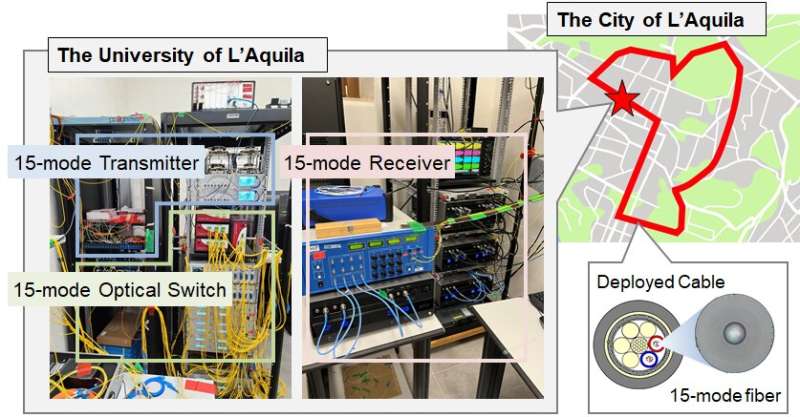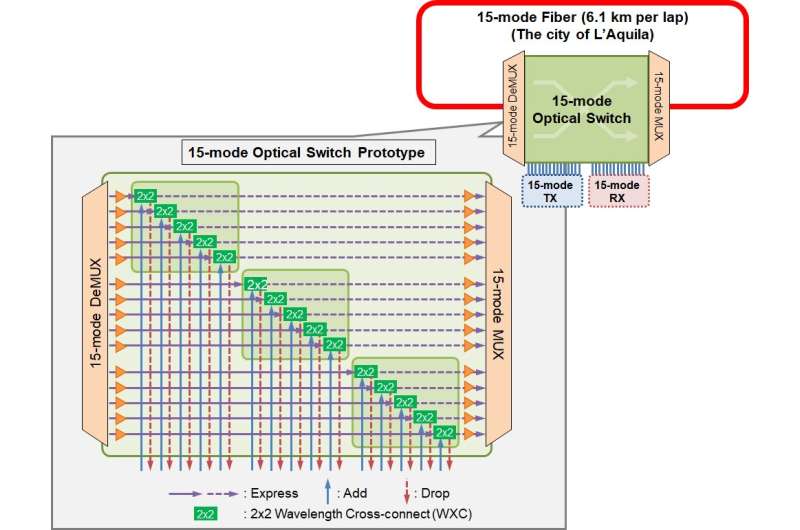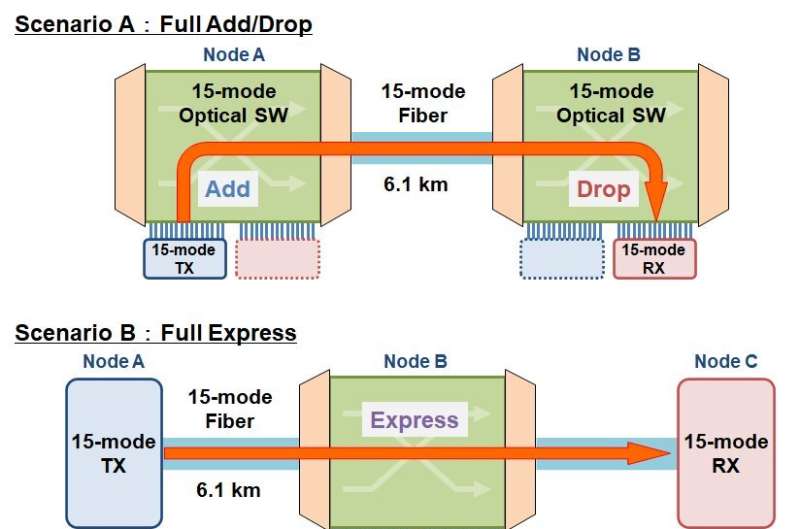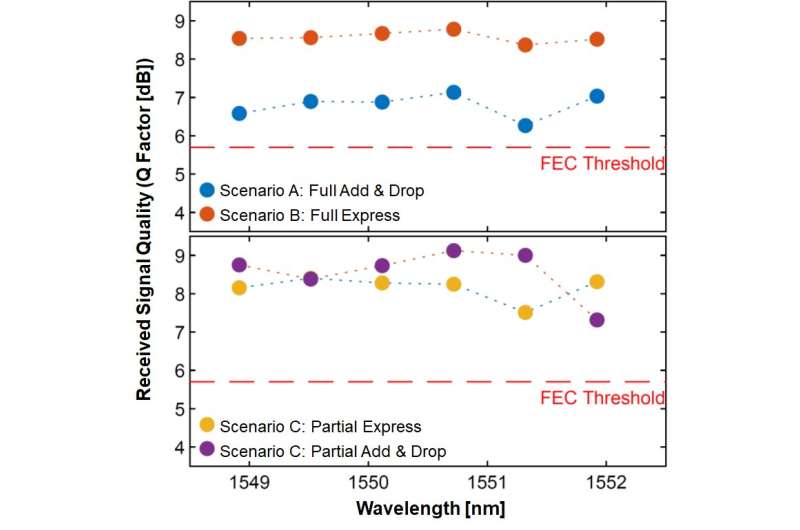
A group of researchers from the Network Research Institute of the National Institute of Information and Communications Technology (NICT, Japan) led by Ruben Soares Luís, along with its partners, has achieved the first demonstration of a field deployed 15-mode optical fiber network, equivalent to 15 parallel fiber networks using a single fiber installed in the city of L’Aquila, Italy.
So far, mode-division-multiplexed fiber communication networks have been demonstrated only in a laboratory environment and the number of switching modes was limited to 10. In this demonstration, the world’s first field-deployed 15-mode fiber with standard cladding diameter, installed in the city of L’Aquila, Italy, was used to support a network node capable of switching up to six 15-mode spatial super channels, each carrying up to 5 terabit per second (Tbit/s) signals using mode-multiplexing.
This was equivalent to implementing 15 parallel optical fiber networks using a single fiber and a single network node, demonstrating the potential for spatial division multiplexing (SDM) systems to greatly extend the capacity of current fiber networks in a realistic environment. The metropolitan 15-mode fiber network was a 6.1 km long and installed in an underground tunnel in the city of L’Aquila. The 15-mode network node was the first 15-mode reconfigurable optical add and drop multiplexer (ROADM), which used reprogrammed conventional wavelength selective switches (WSS). This allowed using the same switch fabric to simultaneously switch multiple modes to greatly reduce the overall cost of the system.

This demonstration shows that mode-multiplexing over multi-mode fibers with a standard cladding diameter, which are compatible with current cabling technologies and have a high spatial channel count, can be adopted in deployed networks and is a significant step toward the realization of a backbone communication systems to support various information communication services after Beyond 5G.
The results of this experiment were accepted as a post-deadline paper presentation at the 48th European Conference on Optical Communication (ECOC 2022) and presented on Thursday, September 22, 2022 local time.
High-capacity SDM technologies have been under research and development, in order to cope with ever-increasing traffic volume. Previously, NICT has successfully demonstrated high-capacity transmission and switching supported by multi-core optical fibers.

However, the use of multi-mode fiber network systems, which have improved spatial density (number of channels per fiber) have been in development. Optical switching of 10 modes or less per multi-mode fiber in a laboratory environment has been demonstrated. Nevertheless, further expansion of the number of modes and verification in a real-world environment are to be expected.
NICT and its partners have implemented a 15-mode fiber network utilizing multi-mode fibers of a field deployed testbed in the city of L’Aquila, Italy. The deployed 15-mode fibers were used to demonstrate mode-multiplexed transmissions up to 48.8 km (8 rounds). In addition, optical switching of 15-mode multiplexed signals using field-deployed fibers was achieved for the first time.
The SDM optical switch prototype was constructed using conventional wavelength selective switches (WSS) programmed to handle signals from multiple modes simultaneously. Effectively, each WSS was equivalent to 5 wavelength cross-connects (WXCs), each with a 2×2 switching capability. A total of 3 WSS were used to switch a total of 15 modes per fiber. A transmitter and the WXC node supporting 15-mode multiplexed signals were located in the facilities of the University of L’Aquila and connected to a field-deployed 6.1 km 15-mode fiber ring.

In the demonstration of optical switching, 15-mode signals with 6 wavelengths were generated. Each wavelength corresponded to a 15-mode spatial super channels with 5 Tbit/s capacity and the total data rate per fiber was 30 Tbit/s. At the network node, the path of each wavelength of the mode-multiplexed signals was directed according to the programmed configuration. Three general functions of a ROADM system were evaluated, including add/drop of all wavelengths, express pass of all wavelengths, and partial express or add/drop of individual wavelengths. For all cases, mode-multiplexed signals were appropriately received after optical switching.
Although mode multiplexing requires digital signal processing at the receiver to compensate for a mode mixing, a mode-multiplexed network utilizing multi-mode fibers with standard diameters can provide a high-density, high-capacity network at low cost. The multi-mode fibers are easy to manufacture, compatible with existing cable technology, and can provide a high-density, high-capacity network at low cost. This demonstration of optical transmission and switching of mode-multiplexed signals on the testbed is an important step toward accelerating research on mode-multiplexed communications and realizing a backbone communication system that supports the evolution of various information services through Beyond 5G.
Provided by
National Institute of Information and Communications Technology (NICT)
Citation:
The world’s first successful optical switching of 15-mode multiplexed signals by spatial optical switch prototype (2022, November 22)
retrieved 22 November 2022
from https://techxplore.com/news/2022-11-world-successful-optical-mode-multiplexed.html
This document is subject to copyright. Apart from any fair dealing for the purpose of private study or research, no
part may be reproduced without the written permission. The content is provided for information purposes only.
Stay connected with us on social media platform for instant update click here to join our Twitter, & Facebook
We are now on Telegram. Click here to join our channel (@TechiUpdate) and stay updated with the latest Technology headlines.
For all the latest Technology News Click Here
For the latest news and updates, follow us on Google News.
